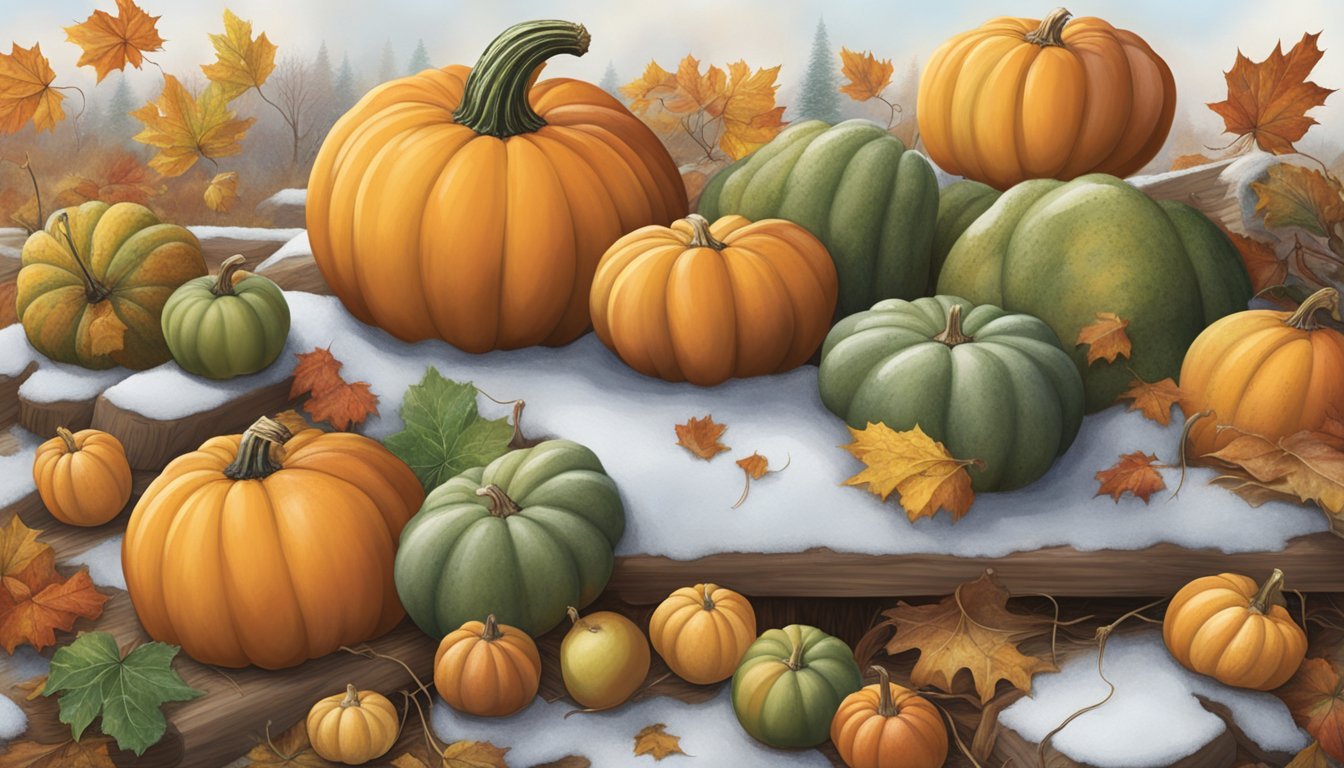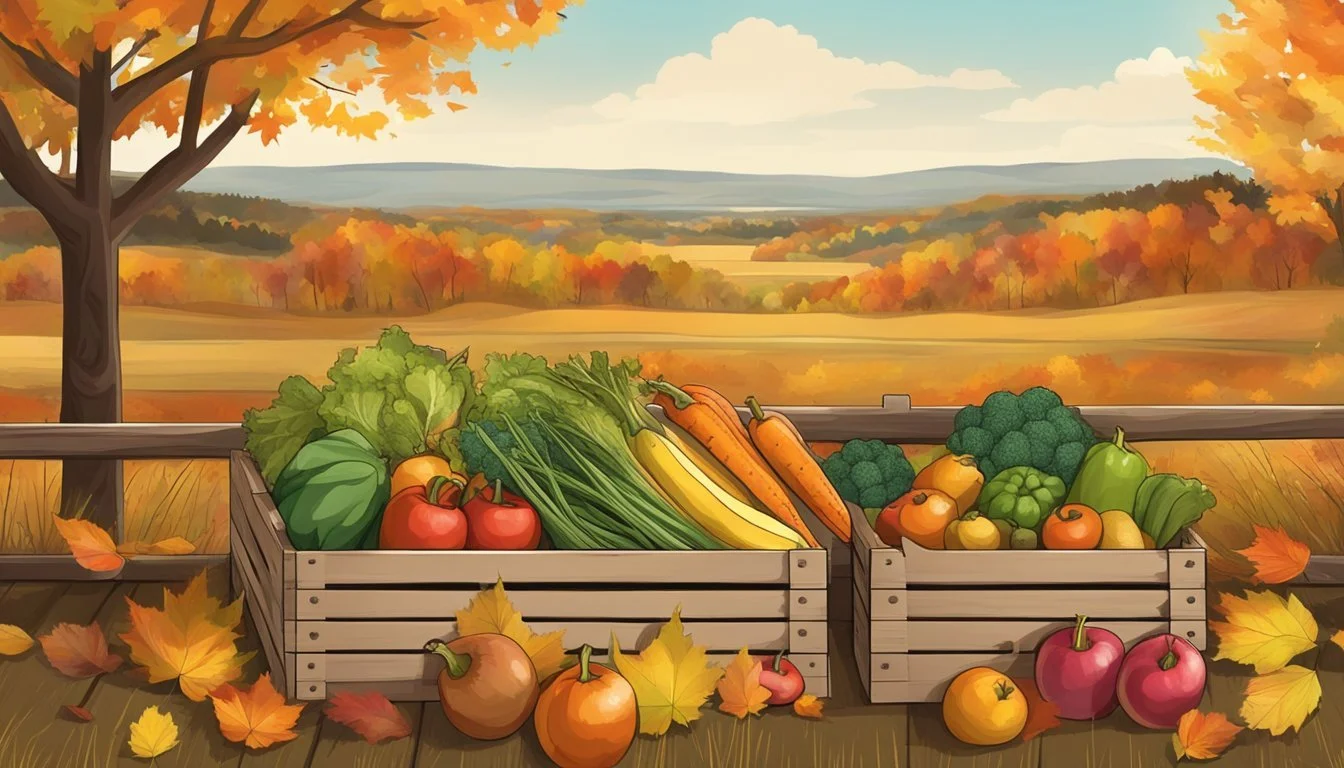North Dakota Seasonal Fruit & Vegetables in November
A Guide to Fresh Produce
This Article is Part of our North Dakota Seasonal Fruit & Veg Calendar
In North Dakota, November marks a transitional period where the fall harvest season winds down and the early signs of winter begin to emerge. The state's agricultural rhythm shifts accordingly, with an array of produce reaching peak freshness. Locally sourced fruits and vegetables during this month not only support regional farmers but also promise higher nutritional value and better flavor for consumers seeking seasonal ingredients.
The offerings from North Dakota's fields and orchards in November might be more limited compared to the abundance of summer, but they are no less significant. Root vegetables and hardy greens typically withstand the cooler temperatures, making them staples in the local diet. Consumers can expect to find a variety of fresh, seasonal produce such as cabbage, which presents in lush red and green varieties, and rutabaga, a sweet root vegetable, readily available at farmers' markets and grocery stores.
Amidst the shorter days and the approach of winter, North Dakota provides an opportunity to embrace the season's bounty. With a focus on what is freshly harvested, individuals can partake in the state's agricultural traditions, infusing their meals with the robust flavors of November's seasonal fruits and vegetables.
Benefits of Eating Seasonal Produce
Eating seasonal produce offers a variety of advantages, from heightened flavor and nutrition to supporting the local economy. This section delves into the specifics of these benefits and how they apply to consuming locally sourced fruits and vegetables in November in North Dakota.
Enhanced Flavor and Nutrition
Seasonal fruits and vegetables harvested at their peak tend to have optimal flavor and nutritional content. The freshness of produce like squash and pumpkins in November means they retain more vitamins and minerals. For instance, Vitamin C, known for its antioxidant properties, and Vitamin A, important for eye health, are found in higher concentrations in fresh produce. Minerals like iron, calcium, magnesium, and potassium are also more abundant in fruits and vegetables picked during their natural growing season.
Support for Local Economy
Purchasing seasonal produce directly benefits local farms and the regional economy of North Dakota. When consumers buy from local farmers, more of their food dollar stays within the community. This not only helps to bolster the local agricultural sector but also fosters new community events and relationships with farmers.
Environmental Advantages
Choosing to eat seasonally and regionally reduces the carbon footprint associated with transporting food across long distances. Seasonal fruits and vegetables in North Dakota require less transportation when they are grown and consumed within the region. Less transportation means reduced greenhouse gas emissions, making it a more environmentally friendly choice.
Health Benefits
Integrating a diverse array of seasonal fruits and vegetables into one’s diet can enhance overall health. The variety adds a spectrum of nutrients and fiber, boosting digestive health and potentially lowering the risk of chronic diseases. Antioxidants found in seasonal produce like leafy greens can help reduce oxidative stress, offering protective benefits against certain types of cancer.
Seasonal Vegetables in November
In November, North Dakota offers a wide array of seasonal vegetables that thrive in the cooler climate. Root vegetables and tubers reach peak quality, while leafy greens and cruciferous vegetables offer fresh options for healthy dishes. Winter squash varieties also become prominent, providing hearty flavors and textures to the seasonal palette.
Root Vegetables and Tubers
Potatoes: These tubers are a staple in the region, valued for their versatility and long storage life.
Sweet Potatoes: With a naturally sweet flavor, they are an excellent source of vitamins and beta-carotene.
Beets (how long do beets last?): Rich in color and nutrients, beets are ideal for roasting or pickling.
Carrots: Available in hues beyond the classic orange, like purple and yellow, these root vegetables are crisp and flavorful.
Root vegetables can be stored in cool, dark places, helping them last throughout the winter months.
Leafy Greens and Cruciferous Vegetables
Kale and Swiss Chard: Hardy greens that can withstand cold temperatures, they remain tender and full of flavor.
Brussels Sprouts (how long do brussels sprouts last?)and Cabbage: These cruciferous vegetables are perfect for roasting and complement rich autumnal dishes.
Lettuce: Although more delicate, some varieties of lettuce can still be harvested in the early part of November.
These greens are often sweeter after a frost, as the cold encourages sugar production, enhancing their natural flavors.
Winter Squash Varieties
Pumpkin: Not just for decoration, pumpkins are ideal for pies, soups, and roasting.
Butternut Squash: With a smooth texture, it's a favorite for soups and purees.
Acorn Squash: Named for its shape, it's excellent baked and stuffed with a variety of fillings.
Delicata and Spaghetti Squash: Delicata is known for its edible skin, while spaghetti squash offers a unique, stringy flesh that resembles noodles when cooked.
Winter squash can serve as a focal ingredient for both sweet and savory dishes, adding a comforting element to meals.
Seasonal Fruits in November
November in North Dakota offers a limited but distinct variety of fruits that remain in season. Consumers can still enjoy fresh, locally harvested produce before the winter sets in.
Late Harvest Fruits
Apples: A staple of the fall, apples are still plentiful in November. Varieties such as Honeycrisp and Fuji offer a crisp texture and a balance of sweet and tart flavors.
Cranberries: These tart berries are traditionally harvested in the fall and are widely available in November, often used in holiday dishes.
Persimmons: Characterized by their sweet, honey-like flavor, persimmons reach their peak in the late fall months.
Exotic and Citrus Fruits
Kumquats: Although not traditionally grown in North Dakota, these small citrus fruits imported from warmer climates are available in November. They are enjoyed for their sweet rind and tart flesh.
Pomegranates: Another fruit that is not native to the region but is in season, the pomegranate offers jewel-like seeds with a sweet and tangy flavor.
While not exhaustive, this selection represents fruits typically found in North Dakota during the month of November that are celebrated for their freshness and seasonal appeal.
Storing and Preserving Fresh Produce
In November, North Dakota's seasonal fruits and vegetables can be maintained at their peak quality through specific storing and preservation techniques. Mastery of these methods ensures a prolonged enjoyment of fresh produce well into the colder months.
Proper Storage Techniques
Fruits and vegetables in season demand varying storage conditions to maintain their freshness. For example, root vegetables such as potatoes, onions, and garlic benefit from cool and dry environments. Moisture and warmth can lead to spoilage, so they should be kept at temperatures between 45-50°F (7-10°C). Similarly, some fruits like apples should also be stored in cool conditions, albeit often in perforated plastic bags to retain humidity and prevent shriveling.
Temperature Control:
Potatoes, onions, and garlic: 45-50°F (7-10°C)
Apples: Refrigerate in perforated plastic bags
Preservation Methods
There are several preservation methods to consider, such as canning, freezing, and drying. Each method has its own advantages and is suited to different types of produce.
Canning: Ideal for a wide variety of produce, canning can be done through water bath or pressure canning. Tomatoes and pickles are commonly canned.
Freezing: This method is quick and easy, and is particularly good for preserving berries and vegetables like peas and corn. It helps retain color, flavor, and nutrients.
Drying: Herbs and sturdy vegetables like squash can be dried. Drying concentrates flavors and prolongs shelf life.
Preservation Method Suitability:
Canning: Tomatoes, pickles
Freezing: Berries, peas, corn
Drying: Herbs, squash
Preparing Seasonal Produce
When preparing seasonal produce from North Dakota in November, one benefits from enhanced flavor and optimal nutrient content. Focusing on simple, healthy recipes and creative cooking ideas maximizes these benefits and allows for a celebration of the season's bounty.
Simple and Healthy Recipes
A person can take advantage of the naturally sweet flavor of roasted root vegetables with minimal effort. For example:
Roasted Sweet Potatoes: Cube sweet potatoes, toss with olive oil, salt, and pepper, and roast until tender.
Brussels Sprouts Salad: Shred Brussels sprouts and mix with a light vinaigrette dressing, dried cranberries (how long do dried cranberries last?), and chopped nuts for a nutritious crunch.
These easy preparations underscore the natural goodness of November's fresh produce while offering warm, nourishing meals.
Creative Cooking Ideas
Those who love to experiment in the kitchen can explore the versatility of in-season vegetables:
Sweet Potato Spaghetti: Replace traditional pasta with spiralized sweet potatoes, sautéed until al dente and served with a hearty sauce.
Vegetable Tart: Layer thinly sliced root vegetables in a pre-baked tart shell, season, and bake until the flavors meld into a rustic, flavorful dish.
Creative twists like adding diced, cooked beets to cocktails for a vibrant hue and earthy taste or using cauliflower as a base in various recipes keep meals interesting and seasonally appropriate. The possibilities are limited only by one's imagination and willingness to explore the full spectrum of November's seasonal produce.
Seasonal Eating Beyond November
As the calendar progresses beyond November, residents of North Dakota experience a shift in seasonal produce. From the heartier selections of winter to the rebirth of freshness in spring, and the abundance of summer, each season offers its distinct array of fruits and vegetables.
Winter Produce Selection
During the winter months (December, January, and February), the availability of fresh produce in North Dakota diminishes due to harsh weather conditions. However, certain root vegetables and stored produce maintain their quality and are still available. Consumers can often find vegetables like:
Potatoes
Carrots
Beets
Winter is also a time when people rely on preserved fruits and vegetables, such as canned tomatoes or frozen blueberries.
Transition to Spring Produce
With the arrival of spring (March, April, and May), a fresh assortment of produce becomes available. Asparagus spearheads the arrival of spring vegetables, often available from April. Other vegetables like radishes and spinach also start to make their way into the market. Greenhouse-grown herbs such as parsley and cilantro are often at their peak this time of year. Towards the end of spring, one can also anticipate:
Green onions
Summer Harvest Variety
The summer months (June, July, August, and September) in North Dakota are ripe for a wide variety of fruits and vegetables. The warmth of the summer sun nurtures a bountiful selection, including:
Cantaloupe
Strawberries
Blueberries
Tomatoes
Peppers
Cucumbers
This period is particularly known for its watermelon, which usually becomes available by late July to early August. Not only does summer bring an assortment of choices, but the long daylight hours in North Dakota allow for robust flavors and plentiful yields, particularly evident in summer squash and green beans.
Understanding Regional Climates
In North Dakota, the climate directly influences the growth patterns and harvest times of regional produce, making understanding seasonal and climatic variations crucial for agricultural success.
North Dakota Hardiness Zones
The United States Department of Agriculture (USDA) has designated hardiness zones to help growers determine which plants are most likely to thrive in a particular location. North Dakota, with its continental climate, ranges primarily from Zone 3a to Zone 4b. These zones are based on the average annual minimum winter temperature and play a significant role in what fruits and vegetables can be successfully cultivated and when. Here's a quick look at the general hardiness zones in North Dakota:
Zone 3a: Temperatures can drop as low as -40 to -35 degrees Fahrenheit.
Zone 3b: Temperatures can drop as low as -35 to -30 degrees Fahrenheit.
Zone 4a: Temperatures can drop as low as -30 to -25 degrees Fahrenheit.
Zone 4b: Temperatures can drop as low as -25 to -20 degrees Fahrenheit.
Impact of Climate on Produce
The state's short growing season is a result of its cold winters and its position in the upper Midwest of the United States. Fruit and vegetable production must align with the climatic realities, such as the first and last frost dates and the length of the growing season. In November, the region has already experienced the first frost, thus ending the growing season for most produce. Here is how the climate impacts seasonal produce:
Temperature: The cool falls extend the season for cold-tolerant crops but limit the availability of warm-season crops.
Frost: The arrival of the first hard frost in this month means the end for sensitive plants.
Daylight: Shorter days and less intense sunlight affect the growth rate of crops.
Farmers in North Dakota adjust their planting schedules and crop choices to these climate constraints, focusing on hardy vegetables that can withstand cooler temperatures and shorter growing seasons in November.
Where to Find Seasonal Produce
In November, North Dakotans can access a variety of fresh, in-season produce through multiple venues ensuring freshness and supporting local agriculture.
Local Farmers Markets
Farmers markets in North Dakota are a primary source for finding seasonal vegetables and fruits directly from regional farms. These markets not only foster community engagement but also allow consumers to buy produce that has often been harvested within 24 hours, ensuring peak freshness and flavor. Shoppers can find a diverse range of late fall harvest items, such as root vegetables and late-season greens.
Community-Supported Agriculture (CSA)
CSA programs serve as a direct pipeline between North Dakota farms and consumers, offering subscription-based shares of the season's harvest. Through CSAs, residents can receive regular distributions of fresh fruits and vegetables that are currently in season, often accompanied by newsletters that contain recipes and farm news. Availability of CSA shares may vary, so it is advisable to inquire with local farms about enrollment periods and share options.
Specialty Food Stores
Specialty food stores in North Dakota often source a variety of local and regional produce, concentrating on quality and seasonality. These stores typically have established relationships with local farms, ensuring a consistent supply of fresh seasonal produce. While the selection may be more curated, these outlets provide an opportunity for consumers to find unique varieties or organic options not readily available at larger grocery stores.
Conclusion
In November, North Dakota's offerings of seasonal fruits and vegetables are limited due to the region's challenging climate. Local markets typically emphasize the importance of root vegetables and hardy greens that can withstand colder temperatures. Carrots, potatoes, and beets tend to dominate produce sections, offering versatility for a variety of autumnal recipes.
It is a transition period where one can still enjoy the last of the hearty squashes and pumpkins, which are prominent during this time for their flavor and festive associations. These vegetables are not only fresh but also contain vital nutrients that are beneficial during the colder months.
Leafy greens such as kale and Swiss chard may still be available and are often found to be even more flavorful after a light frost. Utilizing these greens in dishes is not only a way to enjoy fresh produce but also supports local farmers who contend with the harsher growing conditions of the area.
Although the variety of local, fresh fruits is typically more restricted, storage apples and perhaps late-harvest berries could be found, representing the last whisper of summer's abundance. These fruits, although less varied than during peak season, provide a fresh option for residents looking to support local agriculture and consume seasonally.
For those in North Dakota, embracing the limited but wholesome selection of produce in November means enjoying the freshness of what is available and acknowledging the agricultural rhythm of the region. It is a time to get creative with root vegetables and hearty greens, appreciating their resilience and the nourishment they provide as winter approaches.









